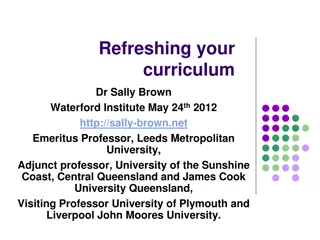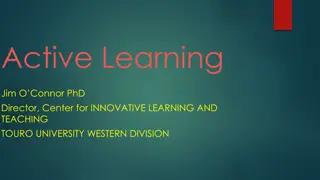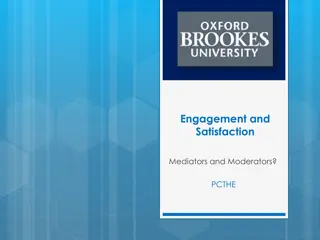Enhancing Active Participation Strategies for Student Engagement
Engaging Them All Active Participation Strategies by Anita L. Archer, Ph.D., focuses on the importance of eliciting frequent responses from students to create a positive learning environment, increase engagement and accountability, and promote desired behaviors. The resource emphasizes the benefits of active participation and provides alternative procedures for implementing participation strategies in teaching.
Download Presentation

Please find below an Image/Link to download the presentation.
The content on the website is provided AS IS for your information and personal use only. It may not be sold, licensed, or shared on other websites without obtaining consent from the author. Download presentation by click this link. If you encounter any issues during the download, it is possible that the publisher has removed the file from their server.
E N D
Presentation Transcript
Engaging Them All Active Participation Strategies 1
Anita L. Archer, Ph.D. Author and Consultant archerteach@aol.com 503-295-7749 2
Resources Additional information can be found in Chapter 6 of this book: Archer, A., & Hughes, C. (2011). Explicit Instruction: Effective and Efficient Teaching. NY: Guilford Publications. Videos that illustrate explicit instruction can be found on this website: www.explicitinstruction.org 3
Goals Participants will be able to: Outline benefits of eliciting frequent responses Reframe questions and strength questions Describe alternative procedures for eliciting responses from students during a lesson. Describe alternative procedures for reading passages in class. Utilize participation procedures in their own teaching. 4
Active Participation Why? Why is it important to frequently elicit responses from students? 5
Feedback Why is it important to frequently elicit responses from students? Contributes to a positive learning environment - increases engagement - increases on-task behavior - increases accountability - promotes desired behaviors - reduces inappropriate behaviors - keeps class moving along 6
Feedback Why is it important to frequently elicit responses from students? Embedded formative assessment Check for understanding - allows the teacher to monitor understanding, adjust the lesson based on responses, and provide feedback to students 7
Feedback Promotes learning - focuses students attention on critical content - provides rehearsal of information and concepts - provides practice of skills and strategies retrieve - respond - retain 8
Active Participation Why? Opportunities to respond related to: Increased academic achievement Increased on-task behavior Decreased behavioral challenges Caveat Only successful responding brings these results Initial Instruction - 80% accuracy Practice/Review - 90% or higher accuracy 9
Create Better Questions (Embedded Formative Assessment by Dylan Wiliam) Original Reframed What end punctuation should be used? Why should this sentence end in a question mark? Is this a sentence or a clause? Why is this a clause rather than a sentence? Is slate a metamorphic rock? Why is slate a metamorphic rock? Is 23 prime? Why is 23 prime? Is a spider an insect? Why is a spider not an insect? Are these lines parallel? 10
Create Better Questions (Embedded Formative Assessment by Dylan Wiliam) Original Reframed using comparisons What is a prime number? Why is 17 prime and 15 not? What was life under apartheid like? How were lives of blacks and whites different under apartheid? Is a bat a mammal? Why is a bat a mammal and penguin not? Does a eukaryote cell have a nucleus? What is the major difference between a prokaryote and eukaryote cells? What are parallel lines? 11
Create Better Questions (Embedded Formative Assessment by Dylan Wiliam) Original Question Reframed as Statement Agree/Disagree/Why or Why Not Are all squares rectangles? All squares are rectangles. Do the Senate and the House of Representatives have the same powers? The Senate and the House of Representatives have the same powers. Is plywood a natural resource? Plywood is a natural resource. Why is Ben Franklin considered a Great American? Why is active participation important? Ben Franklin was a Great American. 12
Active Participation What? Opportunities to Respond Verbal Responses Written Responses Action Responses All Students Respond. When possible, use response procedures that engage all students. 13
Active Participation How can students respond in a lesson? Verbal Responses Written Responses Action Responses 14
Active Participation Brainstorming Think Have students think and record responses. As students are writing, move around the classroom and write down students ideas and their names. Pair Have students share their ideas with their partners. Have them record their partners best ideas. As students are sharing, continue to circulate around the room, recording ideas and names. Share Display the ideas and names on the screen. Use this as the vehicle for sharing. 15
Video What active participation procedures were directly taught? 16
Video Good practices: 17
Preview of Active Participation Procedures Verbal Response Procedures Choral Partners Teams/Huddle Groups Individual Written Response Procedures Types of writing tasks Whiteboards Response Cards/Response Sheets Action Response Procedures Acting out/Simulations Gestures Facial Expressions Hand Signals 18
Elicit frequent responses The active participation procedure should: Involve all students 1. Be structured 2. Allow adequate thinking time 3. 19
Active Participation Essentials Think Time When thinking time was extended beyond 3 seconds these benefits occurred: 1.Greater participation by all learners 2.Length of student responses increased 3.Use of evidence to support inferences increased 4.Logical consistency of students explanations increased 5.Number of questions asked by students increased 20
Verbal Responses Structured Choral Responses Use when answers are short & the same Use when recall and rehearsal of facts is desired Use for quick review of information Students are looking at teacher Ask question Put up your hands to indicate silence Give thinking time Lower your hands as you say, Everyone OR Simply say Everyone 21
Verbal Responses Structured Choral Responses Students are looking at a common stimulus Point to stimulus Ask question Give thinking time Tap for response 22
Verbal Responses Structured Choral Responses Hints for Choral Responses Provide adequate thinking time Have students put up their thumbs or look at you to indicate adequate thinking time If students don t respond or blurt out an answer, repeat (Gentle Redo) 23
Structured Choral Responses What are some benefits of structured choral responses? 24
Verbal Responses Structured Partners Use when answers are long or different Use for foundational and higher order questions Partners Assign partners Pair lower performing students with middle performing students Give partners a number (#1 or #2) Sit partners next to each other Utilize triads when appropriate (#1 #2 #2) Effective secondary procedure Prepare a seating chart indicating names, partners, and numbers 25
Verbal Responses Structured Partners Other hints for partners Teach students how to work together Look, Lean, and Whisper or Look, Lean, Listen, and Whisper Change partnerships occasionally (every three to six weeks) 26
Uses of Partners Responding to a question, task, or directive 1. Teaching information to a partner Studying with a partner 2. 3. 27
Uses of Partners 1. Responding to a question, task, or directive A. Think - Pair - Share Brainstorming ideas 28
A few words about text-dependent questions Fisher & Frey, 2012 Whole Opinions, arguments, intertextual connections Across Texts Inferences Entire Texts Author s Purpose Paragraph Vocabulary Sentence Key Details Word Part General Understanding 29
Partner Uses 1. Responding to a question, task, or directive B. Saying answer to partner (Partners First) 1.Ask a question 2. Give students thinking time 3. Provide a verbal or written sentence starter 4. Have students share answers with their partners using the sentence starter 5. Call on a student to give answer 6. Engage students in a discussion 30
Partner Uses Example Scaffolding Answers with Sentence Starters McDougal Littell Literature 7th Grade Seventh Grade by Gary Soto Example 1. What background information do you learn about Victor in the first paragraph? Start by saying: In the first paragraph, we learn the following information about Victor. First, we learned that___________. Next, we learned that _________________. Finally, we learned ____________. 2. When the boys scowl, they see girls look at them. What might the girls be thinking? Start by saying: When the boys scowl, the girls might be thinking _____________________________________. 31
Partner Uses What are the benefits of having students share answers with their partners before you call on them? 32
Partner Uses Discussion Have students discuss responses to question, task, or directive Scaffold the discussion with sentence starters 33
Discussion Discussion sentence starters Disagreeing I disagree with ________ because ____________. I disagree with ________. I think ______________. Agreeing I agree with ____________ because _____________. I agree with ___________ and I also think _________. 34
Verbal Responses Discussion Adapted from presentation by Kate Kinsella, Ph.D. Structured Discussion Agreeing My idea is similar to __________ idea. I think____________. My ideas expand on _________ idea. I think ____________. I agree with ___________ and want to add_______________. Disagreeing I don t agree with __________ because ________________. I have a different perspective from _______. I think________. My views are different from ____________. I believe______. 35
Verbal Responses Discussion Structured Discussion Clarifying Will you please explain _________________________. What did you mean when you stated ______________. Could you please clarify your idea for me Paraphrasing What I hear you saying is ________________________. So you believe ________________________________. 36
Verbal Responses Partner Uses 2. Teaching information to a partner A. Teach information using: Graphic organizers, maps, diagrams, charts, PowerPoint slides, drawings, notes, vocabulary log, etc 37
Verbal Responses Partner Uses B. Teaching information to partner using worked problems Example #1. What percent of 120 is 90? p 120 = 90 120 p = 90 = 0.75 So 90 is 75% of 120 Example #2. small living room small, dark bedroom famous movie star mysterious, twinkling star 38
Verbal Responses Partner Uses 3. Studying with a partner A. Partner studying (Spelling Example) B. Study content area information using: 1. Textbook, notes, handouts, etc 2. Study - Tell - Help - Check 39
Verbal Responses Partner Uses Studying with a partner A. Study foundation skills using a consistent routine Spelling Example 1. Tutor dictates word 2. Tutee writes the word 3. Tutor displays correctly spelled word Tutee checks the spelling and if the word is misspelled tutee crosses out the word and writes it correctly 4. 40
Verbal Responses Partners Study Give the students a minute or two to study notes, text material, graphic organizer, or handout Tell Ask partners (#1 or #2) to retell what they remember about topic Help Have the second partner assist by: Asking questions Giving hints Telling additional information Check When both partners have exhausted recall, they check with their notes, text material, graphic organizer, or handout 41
Verbal Responses Partners Other uses of partners Monitor partner to see if directions are followed 1. Share materials with partners 2. Assist partners during independent work 3. Collect papers, handouts, assignments for absent partners 4. 42
Verbal Responses Teams Use for higher order questions Use when there are multiple perspectives/opinions Join two partnerships to form a team of four. Label the members of the team with letters (a, b, c, d) OR Indicate by position. Team members sitting in this location will begin sharing. Team members sitting in this location will report to the class. 43
Verbal Responses Teams Rounds First team member shares for a limited time. Other team members ask clarifying questions. Rounds are repeated until all 4 have spoken. Selected reporter summarizes. Reporter reports to the class. 44
Verbal Responses Individual Turns Common but less desirable practices #1. Calling on volunteers Disadvantages: - Specific students volunteer. - high performing students - assertive students - students proficient in English - Non-volunteers over time don t think or participate Limit calling on volunteers. 45
Verbal Responses Individual Turns Common but Less desirable practices #2. Calling on inattentive students Disadvantages: -Inattentive student unlikely to have correct response -Answers of inattentive student unlikely to add to richness of class discourse -Attention is given to inappropriate behavior Don t call on inattentive students. To regain attention of students: Use physical proximity Give directive to entire class Ask students to complete quick, physical behavior 46
Verbal Responses Individual Turns Option #1 - Partner First 1.Ask a question 2. Give students thinking time 3. Provide a verbal or written sentence starter 4. Have students share answers with their partners using the sentence starter 5. Call on a student to give answer 6. Engage students in discussion using discussion sentence starters 47
Verbal Responses Individual Turns Option #2 - Question First 1. Ask a question 2. Raise your hands to indicate silence 3. Give thinking time 4. Call on a student 5. Provide feedback on answer OR Engage students in a discussion 48
Verbal Responses Individual Turns Procedures for randomly calling on students Procedure #1 - Write names on cards or stick. Pull a stick and call on a student. Procedure #2 - Use iPad or iPhone app (e.g., Teacher s Pick, Stick Pick, or Pick Me!) Procedure #3 - Use two decks of playing cards. Tape cards from one deck to desks. Pull a card from other deck and call on a student. 49
Verbal Responses Individual Turns Option #3 - Whip Around or Pass Use when many possible answers 1. Ask a question 2. Give students thinking time 3. Start at any location in the room - Have students quickly give answers - Go up and down rows, limiting comments - Allow student to pass Note: If students are habitual passers, alter the procedure. Return to students who pass. Have them report the best or most interesting idea of their peers. 50























